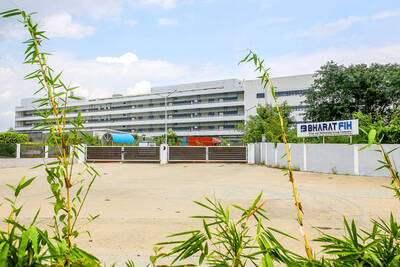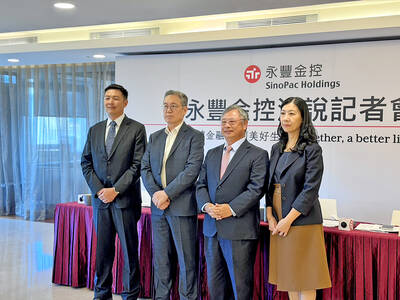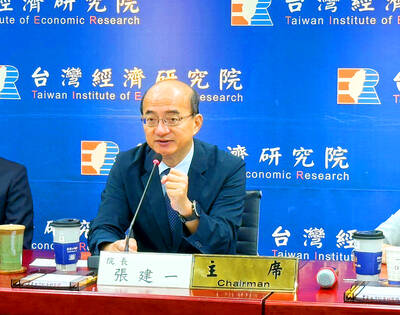The nation’s machinery exports last month expanded 3.7 percent year-on-year to US$2.73 billion, benefiting from robust front-loading demand from US customers amid tariff concerns, the Taiwan Association of Machinery Industry (台灣機械工業同業公會) said yesterday.
That marked the fifth consecutive month of annual growth, as customers requested their products be shipped before yesterday’s expiration of a 90-day reprieve from the US’ tariffs, the association said in a report.
However, drastic appreciation of the New Taiwan dollar tarnished the performance. Machinery exports dipped 4.2 percent annually to about NT$81.53 billion (US$2.8 billion) last month from a year ago, snapping the gains seen in the previous four months, the association’s data showed.

Ritchie B. Tongo, EPA-EFE
Local machinery exporters are losing orders to Asian competitors, while profitability is being squeezed by the local currency’s rise, the association said.
The NT dollar rose 12.4 percent against the US dollar from April 1 to Tuesday, surpassing a 6.7 percent increase for the won, 2.1 percent for the yen and 1.3 percent for the yuan, it said.
A higher US “reciprocal” tariff on Taiwanese goods would deal another blow to local machinery makers, the association said.
The White House on Monday announced 25 percent import duties on Japan and South Korea. In early April, the US set a 32 percent tariff on Taiwan.
During the first six months of this year, machinery exports expanded 5.3 percent annually to US$14.92 billion, the data showed.
The US was the top export destination for local machinery suppliers, with shipments totaling US$3.97 billion in the first half of this year, up 16.3 percent annually.
China followed, with exports inching up 1.1 percent to US$2.41 billion, while Japan was third, with exports of US$1.2 billion, rising 14.1 percent annually, data showed.
Metrology equipment was the largest export item, making up 17.6 percent with US$2.62 billion of exports during the six-month period. Electronic equipment made up 16 percent of the total, with exports of US$2.38 billion, while machinery tools made up 6.8 percent, with exports of US$1.01 billion, data showed.
Taiwan imported about US$32.39 billion of machinery during the January-to-June period, surging 53.5 percent from the same period last year, the association said.
Electronic equipment was the biggest item purchased by local firms, soaring 85.9 percent from last year with US$14.19 billion in spending. That made up 43.8 percent of total imports.
Metrology equipment followed with imports of US$7.9 billion, accounting for 24.4 percent, and spiking 80.6 percent annually. Turbines were a distant third with imports plummeting 28.6 percent year-on-year to US$1.29 billion, making up 4 percent of the total, data showed.

SETBACK: Apple’s India iPhone push has been disrupted after Foxconn recalled hundreds of Chinese engineers, amid Beijing’s attempts to curb tech transfers Apple Inc assembly partner Hon Hai Precision Industry Co (鴻海精密), also known internationally as Foxconn Technology Group (富士康科技集團), has recalled about 300 Chinese engineers from a factory in India, the latest setback for the iPhone maker’s push to rapidly expand in the country. The extraction of Chinese workers from the factory of Yuzhan Technology (India) Private Ltd, a Hon Hai component unit, in southern Tamil Nadu state, is the second such move in a few months. The company has started flying in Taiwanese engineers to replace staff leaving, people familiar with the matter said, asking not to be named, as the

The prices of gasoline and diesel at domestic fuel stations are to rise NT$0.1 and NT$0.4 per liter this week respectively, after international crude oil prices rose last week, CPC Corp, Taiwan (台灣中油) and Formosa Petrochemical Corp (台塑石化) announced yesterday. Effective today, gasoline prices at CPC and Formosa stations are to rise to NT$27.3, NT$28.8 and NT$30.8 per liter for 92, 95 and 98-octane unleaded gasoline respectively, the companies said in separate statements. The price of premium diesel is to rise to NT$26.2 per liter at CPC stations and NT$26 at Formosa pumps, they said. The announcements came after international crude oil prices

SinoPac Financial Holdings Co (永豐金控) is weighing whether to add a life insurance business to its portfolio, but would tread cautiously after completing three acquisitions in quick succession, president Stanley Chu (朱士廷) said yesterday. “We are carefully considering whether life insurance should play a role in SinoPac’s business map,” Chu told reporters ahead of an earnings conference. “Our priority is to ensure the success of the deals we have already made, even though we are tracking some possible targets.” Local media have reported that Mercuries Life Insurance Co (三商美邦人壽), which is seeking buyers amid financial strains, has invited three financial

CAUTION: Right now, artificial intelligence runs on faith, not productivity and eventually, the risk of a bubble will emerge,’ TIER economist Gordon Sun said Taiwanese manufacturers turned more optimistic last month, ending a five-month streak of declining sentiment as concerns over US tariffs, currency volatility and China’s overcapacity began to ease, the Taiwan Institute of Economic Research (TIER) said yesterday. The manufacturing business confidence index rose 1.17 points from June to 86.8, its first rebound since February. TIER economist Gordon Sun (孫明德) attributed the uptick to fading trade uncertainties, a steadier New Taiwan dollar and reduced competitive pressure from Chinese producers. Taiwan’s semiconductor industry is unlikely to face significant damage from Washington’s ongoing probe into semiconductors, given the US’ reliance on Taiwanese chips to power artificial